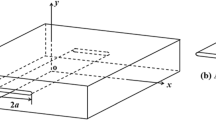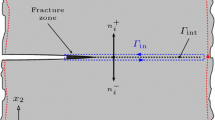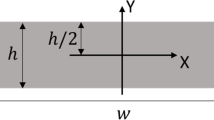Abstract
The true nature and characteristics of crack growth mechanisms in geologic materials have not been adequately described and are poorly understood. The process by which deformation energy is converted to slipping and growing cracks under compressive stresses is complex and difficult to measure. A hybrid technique employing moiré interferometry as an experimental boundary condition to a finite element method (FEM) was employed for through-cracked polycarbonate plates under remote shear and compression. Cohesive end zone and dislocation slip models are used to approximate experimentally observed displacement characteristics. Shear-driven linear elastic fracture mechanics displacement predictions are shown to be inadequate for initial displacement progression. Moiré displacement fields of relative crack face slip reveal a near tip cohesive zone. The pre-slip moiré-FEM stress fields reveal that the maximum crack tip tensile stress occurs at approximately 45 degrees and further infers cohesive zone presence. A J integral formulation uses moiré displacement data and accounts for stored energy along the crack before and after shear driven crack face slip. These energy-partitioning results track the transfer of stored energy along the crack face to the crack tip until the entire crack is actively slipping. These laboratory-scale experiments capture basic mechanical behavior and simulate thousands of years of large-scale geologic feature displacement history in just a few hours.
Similar content being viewed by others
References
ABAQUS (1997). Providence, RI., Hibbitt, Karlsson & Sorensen, Inc., Version 5.8. H.K.S. Publishing.
Barenblatt, G. I. (1962). Advances in applied mechanics, Academic Press, London.
Barker, D.B., Sanford, R.J. et al. (1985). Determining K and related stress field parameters from displacement fields. Exp. Mech. 25(4), 399–407.
Bobet, A. and Einstein, H.H. (1998). Fracture coalescence in rock-type materials under uniaxial and biaxial compression. Int. J. Rock Mech. Min. Sci. 35(7), 863–888.
Brown, S.R. (1993). Laboratory measurements of frictional slip on interfaces in a polycarbonate rock mass model. Albuquerque, Sandia National Laboratory.
Buescher, B.J., Perry, K.E. et al. (1996). Frictional sliding in layered rock: laboratory-scale experiments. Albuquerque, Sandia National Laboratory.
Burgman, R., Pollard, D.D. et al. (1994). Slip distributions on faults: effects of stress gradients, inelastic deformation, heterogeneous host-rock stiffness, and fault interaction. J. Struct. Geol. 16(12), 1675–1690.
Chona, R. and Matsumoto, R. (1990). Determining crack tip stress field parameters from mixed mode displacement fields. Society for Experimental Mechanics Spring Meeting, Albuquerque, NM, SEM.
Cowie, P.A. and Scholz, C.H. (1992). Physical explanation for the displacement-length relationships of faults using a post-yield fracture mechanics model. J. Struct. Geol. 14(10), 1133–1148.
Cowie, P.A. and Shipton, Z.K. (1998). Fault tip displacement gradients and process zone dimensions. J. of Struct. Geo. 20(8), 983–997.
Creath, K. (1993). Temporal phase measurement methods - Ch. 4. Interferogram analysis - digital fringe pattern measurement techniques. D.W. Robinson and G.T. Reid, Institute of physics publishing Ltd., 94–140.
Deason, V.A. and Ward, M.B. (1989). A compact portable diffraction grating interferometer. Laser Interferometry: Quantitative Analysis of Interferograms, Bellingham, WA.
Dugdale, D.S. (1960). Yielding of steel sheets containing slits. J. Mech. Phys. Sol. 8, 100–104.
Epstein, J.S., Lloyd, W.R. et al. (1993). Biaxial load system for elasto-plastic interface testing. Novel Experimental Techniques in Fracture Mechanics. A. Shukla. New Orleans, LA, ASME Publications, New York, NY. 76, 237–246.
Erdogan, F. and Sih, G.C. (1963). On the crack extension in plates under plane loading and transverse shear. Trans. Am. Soc. Mech. Engng. 85, 519–527.
Greivenkamp, J.E. and Bruning, J.H. (1986). Phase shifting interferometry. Optical Shop Testing. D. Malacara. Hoboken, NJ, Wiley-Interscience.
Hallam, S.D. and Ashby, M.F. (1990). Compressive brittle fracture and the construction of multi-axial failure maps. Deformation Processes in Minerals, Ceramics and Rocks. D.J. Barber and P.G. Meredith. London, Unwin Hyman LTD. 1, 435–578.
Horii, H. and Nemat-Nasser, S. (1986). Brittle failure in compression: splitting, faulting and brittle-ductile transition. Phil. Trans. R. Soc. Lond. A319, 337–374.
Ida, Y. (1972). Cohesive force across the tip of longitudinal shear crack and Griffith’s specific surface energy. J. Geophys. Res. ???, 3796–3805.
Ingraffea, A. (1987). Theory of crack initiation and propagation in rock. Fracture Mechanics of Rock, Ch. 4. B.K. Atkinson, Academic Press, 71–110.
Li, V.C. (1987). Mechanics of shear rupture applied to earthquake zones. Fracture Mechanics of Rocks. B.K. Atkinson. New York, Academic Press, 351–428.
Liechti, K.M. and Chai, Y.-S. (1992). Asymmetric shielding in interfacial fracture under in-plane shear. J.A.M. 59, 295–304.
Martel, S. and Pollard, D.D. (1989). Mechanics of slip and fracture along small faults and simple strike slip fault zones in granite rock. J. Geophys. Res. 94(B7), 9417–9428.
Martel, S.J. (1997). Effects of cohesive zones on small faults and implications of secondary fracturing and fault trace geometry. J. Struct. Geol. 19(6), 835–847.
McClintock, F.A. (1962). Friction on Griffith’s cracks in rocks under pressure. U.S. National Congress on Applied Mechanics, ASME.
Muraoka, H. and Kamata, H. (1983). Displacement distribution along minor fault traces. J. Struct. Geol. 5, 483–495.
Olsson, W.A. (1982). Experiments on a slipping crack. Geo. Res. Let. 9(8), 797–800.
Olsson, W.A. (1984). A dislocation model of the stress history dependence of frictional slip. J. Geophys. Res. 89(B11), 9271–9280.
Palmer, A.C. and Rice, J.R. (1973). The growth of slip surfaces in progressive failure of over consolidated clay. Roy. Soc. London.
Perry, K.E., Epstein, J.S. et al. (1995). Frictional sliding on rock: preliminary experiments on LEXAN. 35th US National Rock Mechanics Symp., Lake Tahoe, CA/NV, A.A. Balkema.
Post, D., Czarnek, R. et al. (1988). Deformation and strains in a thick adherend lap joint. Adhesively bonded joints: Testing, analysis and design, ASTM STP 981. W.S. Johnson, American Society for Testing and Materials, 107–118.
Post, D., Han, B. et al. (1994). High sensitivity moire: experimental analysis for mechanics and materials. Springer-Verlag, New York.
Rice, J.R. (1968). Fracture, an advanced treatise: mathematical fundamentals. Academic Press, New York
Rice, J.R. (1980). The mechanics of earthquake rupture. Physics of the Earth’s Interior. A.M. Dziewonski. North Holland, 555–644.
Rudnicki, J.W. (1980). Fracture mechanics applied to the earth’s crust. Ann. Rev. Earth Planet Sci 8, 489–525.
Ruiz, C., Post, D. et al. (1985). Moire interferometric studies of dovetail joints. J. Appl. Mech. 52(1), 109–114.
Shen, B., Stepheansson, O. et al. (1995). Coalescence of fractures under shear stress in experiments. J. Geophys. Res. 100(B4), 5975–5990.
Steffler, E.D. (1994). Subcritical crack growth behavior of waste isolation glass. Mechanical Engineering. Laramie, WY, University of Wyoming, 80.
Steffler, E.D. (1999). Frictional sliding energy partitioning of a center crack loaded in remote shear and compression. Mechanical Engineering Department. Las Cruces, NM, New Mexico State University.
Steffler, E.D., Coon, D.N. et al. (1992). Fracture statistics of waste isolation glass. Spectrum’ 92 Nuclear and Hazardous Waste Management, Boise, ID.
Steffler, E.D., Coon, D.N. et al. (1994). Subcritical crack growth behavior of ISV waste isolation glass. Spectrum’ 94 nuclear and hazardous waste management, Atlanta, GA.
Steffler, E.D., May, G.B. et al. (1992). Energy dissipation processes affecting crack growth in quasi-brittle materials. 33rd U.S. National Rock Mechanics Symposium, Sweeney Convention Center, Santa Fe, NM, A.A. Balkema Publishers.
Steif, P.S. (1984). Crack extension under compressive loading. Eng. Frac. Mech. 20(3), 463–473.
Tada, H., Paris, P. et al. (1973). The stress analysis of cracks handbook, Del Research Company.
Walsh, J.J. and Watterson, J. (1988). Analysis of the relationship between displacements and dimensions of faults. J. Struct. Geol. 10, 239–247.
Weertman, J. (1964). Continuum distributions of dislocations distributed on a fault with finite friction. Bull. Seismol. Soc. Am. 54, 1035–1058.
Willemse, E.J.M. and Pollard, D.D. (1998). On the orientation and patterns of wing cracks and solution surfaces at the tips of a sliding flaw or fault. J. Geophys. Res. 103(B2), 2427–2438.
Williams, M.L. (1957). On the stress distribution at the base of a stationary crack. J.A.M. 24, 109–114.
Author information
Authors and Affiliations
Rights and permissions
About this article
Cite this article
Steffler, E., Epstein, J. & Conley, E. Energy partitioning for a crack under remote shear and compression. International Journal of Fracture 120, 563–580 (2003). https://doi.org/10.1023/A:1025511703698
Published:
Issue Date:
DOI: https://doi.org/10.1023/A:1025511703698




